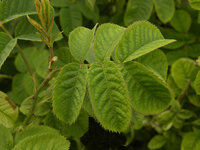Gallicas, damascenes, centifolias, albas - the flowers often look more or less similar and are difficult to distinguish. Many are densely double, quartered and have a rosette around one eye. Colour helps a little: Gallicas come in many shades of red from pink to velvety dark purple, also striped, spotted or marbled. Damasceners can be white or pink, only a few exceptions are darker coloured. Albas are white or light pink. Centifoliums are mostly pink, but can also be dark coloured like some Gallicas or white like some Damascens. Even without flowering, one can see distinct differences.
Often you can already tell what is typical by the shape of the bush. Gallicas grow upright and dense. The flowers stand upwards. They usually have irregular, rather straight spines and bristles that can be brushed off with the hand. On old shoots sometimes only the base of the spines and bristles can be seen. The leaves are often coarse and somewhat dull green, never glossy. The upper side of the leaflets looks somewhat structured ("waffled") due to the nerves. The round calyx is clearly separated from the flower stalk. The rosehips are round.

Gallica-Bush, Photo: Hella Brumme
Waffled Gallica-foliage, Photo: Europa-Rosarium
Damasceners grow loosely, broadly, often irregularly and taller than Gallicas. The shoots are curved with many side branches, the spines are numerous, unevenly sized, somewhat hooked or sickle-shaped, with a broad base. The foliage is fresh green and slightly blistered ("unironed"). The flower stalks are thin and long and merge into the urn-shaped calyx without a shoulder. The sepals are long and pinnate. In the inflorescences the central flower sits lower and blooms first. The rose hip is elongated and asymmetrically attached to the stem.

Damask rosehip, Photo: Hella Brumme
Unironed damask leaves, Photo: Hella Brumme
Centifolias grow somewhat sparsely loosely overhanging, the shoots can grow up to 2 metres long. The heavy flowers hang and often bend the branches down to the ground. Thin shoots often grow in a jumble in the shrub, a "messy" growth. The numerous spines vary in size, mostly hooked, with bristles and glands between them on the shoots. The foliage is softer than on Gallicas and smoother, it often hangs down. The buds are more elongated than the round Gallica buds and mostly covered with glands. The calyx is also covered and usually oval-elliptical to funnel-shaped. The flower stalk merges smoothly into the calyx, not separated as in Gallicas or Albas. The densely double flowers are large and rounded with an intense fragrance. They flower for a long time in June, the flowers opening one after the other.

Spines on young centifolia shoot, Photo: Gerd Hartung
Funnel-shaped calyx with centifolia, Photo: Hella Brumme
Centifolia flower, Photo: Hella Brumme
Alba roses are mostly tall shrubs with long, slightly overbent shoots. Typical for them is the more or less bluish grey-green foliage. The leaflets are slightly frosted on the upper side and softly hairy on the underside. Young shoots are bluish frosted (a wax layer that can be wiped off). The spines are unevenly distributed and not very dense, in some varieties only a few, in others more numerous. The spines are more uniform than those of damasceners. The flowers are usually in small clusters and are medium to large, slightly double to double. The calyx is elongated, not round as in Gallicas, but also clearly separated from the flower stalk. The rosehips are similar to Canina rosehips, i.e. elongated-ovate and smooth, they are clearly set off from the fruit stalk.

Alba-Rose hips, Photo: Gerd Hartung
Young ripened Alba drifted, Photo: Hella Brumme
These are the typical and distinguishable characteristics in gallicas, damascenes, albas and centifolias. However, there are many crosses between them, in which sometimes one, sometimes the other characteristic predominates. The classification into the different classes is mostly done according to the predominant traits and is also not always comprehensible.
Authors: Hella Brumme and Eilike Vemmer






